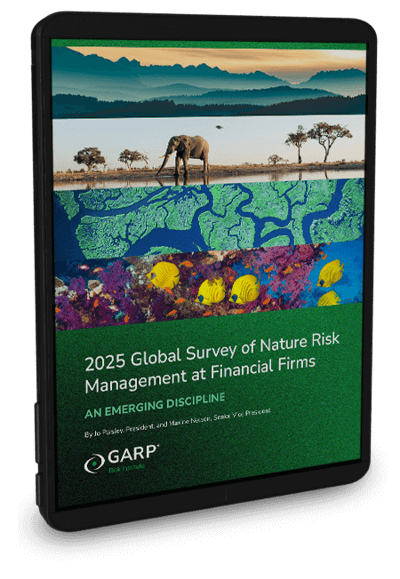Global Survey of Nature Risk Management at Financial Firms
An Emerging Discipline
May 6, 2025
Nature underpins both our economies and livelihoods. Indeed, the entirety of our economy depends in some way on nature, for example through its provision of ecosystem services, such as clean water, raw materials, and medicine.
The less resilient nature is, the more likely we will suffer economic and financial losses, leading to negative impacts on the real economy and financial firms. Cognizant of the critical importance of nature, an increasing number of policymakers and financial regulators have established formal nature or environmental expectations of firms.
Against this backdrop, GARP undertook it second global survey of nature risk management, comprising 48 financial firms. Our 2025 survey provides valuable insights of current nature risk management practices across the financial services industry, as well as helping firms prioritize areas to improve upon along their nature risk journey.
Key Takeaways:
-
Board oversight of nature risk is increasing, but more documentation is needed. Half of all firms in the 2025 survey have board oversight of nature-related risks, up from 46% in the 2024 survey, with meetings held more frequently to discuss nature-related issues. Worryingly, 17% of boards with this responsibility still have not been presented with any papers.
-
Risk identification is on the rise. Forty-two percent of firms reported that they have identified nature-related risks or opportunities, up from 25% in 2024. Moreover, the percentage of firms reviewing nature-related risks and opportunities across their risk management and strategy functions has doubled.
-
Counterparty risk assessment has increased significantly. Forty-six percent of firms are assessing their counterparties’ impacts on nature (up from 27% last year) in their due diligence. These firms are also taking action in response — most commonly in the form of increasing engagement and enhancing their due diligence.
-
The use or intention to use metrics, targets, or limits has risen modestly. Twenty-one percent of firms are already using them to manage nature-related risks, but 62% are either working on this or intend to do so.
-
While relatively few firms are conducting scenario analysis, there is an expectation that many will use this in the future. Just 21% of firms are now using nature scenario analysis, but a further 52% plan on doing so.
About the authors
Jo Paisley, President, GARP Risk Institute, has worked on a variety of risk areas at GARP Risk Institute, including stress testing, operational resilience, model risk management, and climate and environmental risk. Her career prior to joining GARP spanned public and private sectors, including working as the Director of the Supervisory Risk Specialist Division within the Prudential Regulation Authority and as Global Head of Stress Testing at HSBC.
Dr. Maxine Nelson, Senior Vice President, GARP Risk Institute, currently focuses on climate and environmental risk management. She has extensive experience in risk, capital, and regulations gained from a wide variety of roles across firms including Head of Capital Planning at HSBC. She also previously worked at the UK Financial Services Authority, where she was responsible for counterparty credit risk during the last financial crisis.

Want to read more?
Download the full report now!